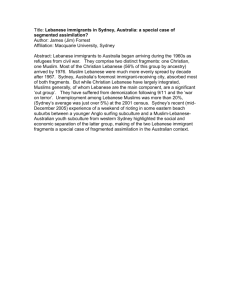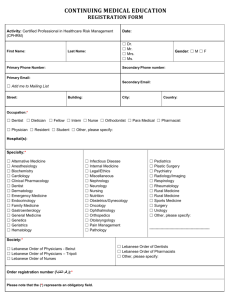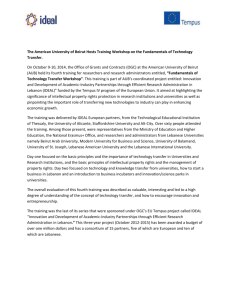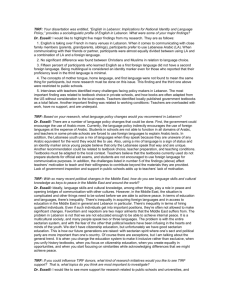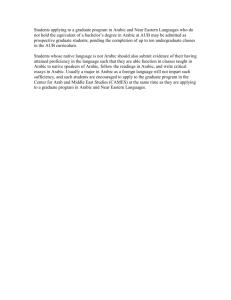The Syriac of the Maronite Qorbono (Mass)
advertisement
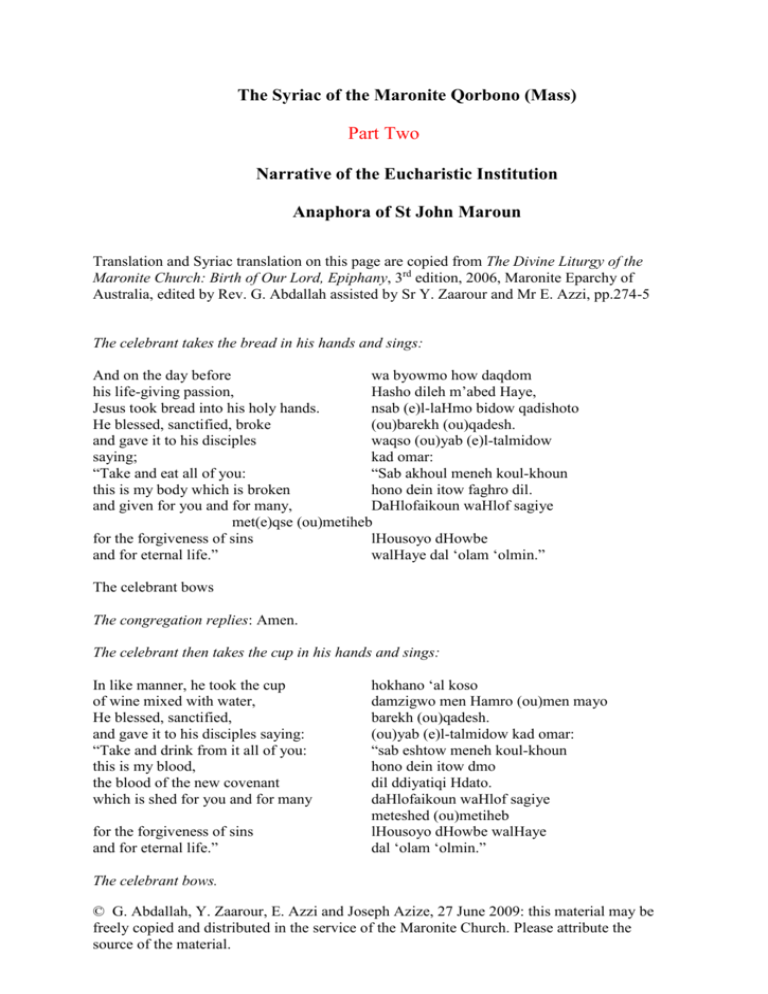
The Syriac of the Maronite Qorbono (Mass) Part Two Narrative of the Eucharistic Institution Anaphora of St John Maroun Translation and Syriac translation on this page are copied from The Divine Liturgy of the Maronite Church: Birth of Our Lord, Epiphany, 3rd edition, 2006, Maronite Eparchy of Australia, edited by Rev. G. Abdallah assisted by Sr Y. Zaarour and Mr E. Azzi, pp.274-5 The celebrant takes the bread in his hands and sings: And on the day before wa byowmo how daqdom his life-giving passion, Hasho dileh m’abed Haye, Jesus took bread into his holy hands. nsab (e)l-laHmo bidow qadishoto He blessed, sanctified, broke (ou)barekh (ou)qadesh. and gave it to his disciples waqso (ou)yab (e)l-talmidow saying; kad omar: “Take and eat all of you: “Sab akhoul meneh koul-khoun this is my body which is broken hono dein itow faghro dil. and given for you and for many, DaHlofaikoun waHlof sagiye met(e)qse (ou)metiheb for the forgiveness of sins lHousoyo dHowbe and for eternal life.” walHaye dal ‘olam ‘olmin.” The celebrant bows The congregation replies: Amen. The celebrant then takes the cup in his hands and sings: In like manner, he took the cup of wine mixed with water, He blessed, sanctified, and gave it to his disciples saying: “Take and drink from it all of you: this is my blood, the blood of the new covenant which is shed for you and for many for the forgiveness of sins and for eternal life.” hokhano ‘al koso damzigwo men Hamro (ou)men mayo barekh (ou)qadesh. (ou)yab (e)l-talmidow kad omar: “sab eshtow meneh koul-khoun hono dein itow dmo dil ddiyatiqi Hdato. daHlofaikoun waHlof sagiye meteshed (ou)metiheb lHousoyo dHowbe walHaye dal ‘olam ‘olmin.” The celebrant bows. © G. Abdallah, Y. Zaarour, E. Azzi and Joseph Azize, 27 June 2009: this material may be freely copied and distributed in the service of the Maronite Church. Please attribute the source of the material. 2 The congregation replies: Amen. 3 The Syriac of the Eucharistic Institution We could have taken the Syriac from any of the anaphorae. The Syriac in the qorbono (our Maronite word for the “Mass”) is always the same: only other parts of the anaphorae change. wa byowmo how daqdom wa = “and”, just as in Arabic and Lebanese. b = “on”, just as in Lebanese. yowmo = “the day”, as in Arabic and Lebanese, but Syriac had no word for “the”. It is the adoption of “al” from Arabic which, more than anything else, makes Lebanese sound as if it were an Arabic dialect. how = “that”. da = “which”, a purely Syriac and Aramaic word. After this word, Syriac does not need to state “is” or “was”, it is understood, just as in Lebanese we say “ana mabsoot”, literally, “I happy”, obviously meaning “I am happy”. qdom = “before”, the root Q-D-M means this in Arabic and Lebanese, but in Lebanese the “q” is is given a “soft” pronunciation, as if it were an aleph.. Putting this together, it says “And on the day, that which (was) before ...” Hasho dileh m’abed Haye Hasho = “the Passion”, a Syriac word for the passion of Our Lord. dileh = “His”, a purely Syriac word. m’abed = “working”, “producing” or “effecting”. In Arabic this root can mean “slave”, and in Lebanese we speak of al ‘abd, or “the slave”. The Syriac verb has a slightly different meaning: it means “to do”, “to cause”, “to perform”. Here the added “m” makes the word an adjective. Haye = “life”, it also has the same meaning in both Arabic and Lebanese. Putting this together, it says “His life-causing Passion ...” nsab (e)l-laHmo bidow qadishoto nsab = “he took”, a Syriac word 4 (e)l-laHmo = “bread”, unlike Lebanese or Arabic where laHm is “meat”. Note the l which is written after nsab. It is a Syriac way of indicating what he took. bidow = “in his hands”, the bi meaning “in” has merged with the word idow meaning “his hands”. Note that the Syriac word for “hand” is id, pronounced eed. This is the same as the Lebanese, whereas the Arabic is not id but yad. At the end of the word, the ow which means “his” is once more Lebanese, not Arabic “hu”. qadishoto = “holy”. The root Q-D-SH for “holy” becomes Q-D-S in Arabic and ‘-D-S in Lebanese. The old Lebanese root was Q-D-SH, as in the place name “Qadisha”. Putting this together, it says “He took bread in His holy hands ...” (ou)barekh (ou)qadesh (ou)barekh = “(and) He blessed”, the ou is “and”, just as in Lebanese, and barekh is “He blessed”, as in Arabic and Lebanese barak. Note that in Syriac a “k” followed by a vowel is often pronounced as “kh” (ou)qadesh = “(and) He sanctified”, once more, the Q-D-SH root. Putting this together, it says “He blessed and sanctified (it) ...” waqso (ou)yab (e)l-talmidow kad omar: waqso = “and He broke”, qSo, with the letter Sad, being the Syriac word “to break” (ou)yab = “and He gave”, a Syriac verb with a distant Arabic cousin. (e)l-talmidow = “to his disciples”, l means “to”, closer to the Lebanese meaning than the Arabic, while the word talmid was taken from Syriac into Arabic as talmidh and into Lebanese as talmiz. Two dots in the Syriac show that the noun here is plural. kad = “while”, a Syriac word. This explains why the celebrant speaks the words of consecration while he holds the elements in his hands. omar = “He said”, related to the Arabic and Lebanese word amr “to order”. Putting this together, it says “He broke and He gave (it) to His disciples while He said ...” At this point the chant of the celebrating priest becomes particularly solemn, for he is speaking what may be the very words used by the Lord, affirming His sacrifice. “Sab akhoul meneh koul-khoun sab = “take”, the imperative of the verb nsab, which we saw above. 5 akhoul = “eat”, as in Arabic and Lebanese akal. meneh = “of / from it” as in Lebanese; Arabic has the final vowel after the “h”. koul-khoun = “all of you”, as in Lebanese. Arabic would have kum for “you”. Putting this together, it says “Take and eat of it all of you ...” hono dein itow faghro dil hono = “this”, similar to but a little different from Arabic and Lebanese. dein = “for”, probably a Greek word taken into Syriac, it can never be the first word in the sentence, but in translation it will usually precede the word before it. itow = “is”, by a circuitous path, this word is our Lebanese fee meaning “there is”. faghro dil = “My body”, fagro being a very ancient word, and dil meaning “my”, like Lebanese illi, but with the Syriac d in front. Putting this together, it says “For this is My body ...” DaHlofaikoun waHlof sagiye daHlofaikoun = da “which” plus Hlaf, which means “on behalf of”, “instead of”, or – as here – “for”. koun is, once more, “you”. However, the nuance here hints that Our Lord’s sacrifice is made so that we might live. waHlof = wa “and” Hlof “and for”. sagiye = “many”. Note that as in the Gospel, it is “for many” not the incorrect translation “for all” used by some outside the Maronite church. Putting this together, it says “which for you and for many ...” met(e)qse (ou)metiheb met(e)qse = “is broken”. We have seen the verb qSo “to break”. Here, the “m” makes an adjective, and the “t” makes it the passive form. (ou)metiheb = “is given”. This is the verb yab “to give”, with an “m” for an adjective, and the “t” for the passive. The “h” seems to appear from nowhere, but in fact, although it is not pronounced in the verb yab, the Syriac writing retains it. We do the same thing in English: we write “muscle” with an unpronounced “c”. However, in the word “muscular” it reappears in pronunciation. Putting this together, it says “is broken and given ...” 6 lHousoyo dHowbe walHaye dal ‘olam ‘olmin” lHousoyo = l “for” as in Arabic and Lebanese, with Housoyo “forgiveness”, a Syriac word not known in Arabic or Lebanese. dHowbe = d “of” plus Howbe a Syriac word for “sins”. walHaye = wa “and”, with l “for” and Haye “life”, as we saw above. da = “which” l ‘olam ‘olmin = “(is) of eternity of eternities”, that is “eternal”. Literally, it says “for eternity of eternities”. It is similar to the Latin in saecula saeculorum, literally, “during the age of ages”. Putting this together, it says “for the forgiveness of sins, and for eternal life ...” To this, the congregation replies “Amen”, a Hebrew word which is related to Lebanese and Arabic “amin” meaning “faithful”. In Hebrew it tells the hearer to have faith in what is said, and serves as a prayer, “may it come to be”. Our Lord’s speech was distinctive in how He would affirm His own words by saying “Amen”. St John, who was justifiably proud of his closeness to Jesus, preserved in his Gosepl, Our Lord’s unique habit of saying “amen, amen”, and in the Apocalypse (the Book of Revelation) even refers to Him as “the Amen”: And to the angel of the church of Laodicea write: ‘These things saith the Amen, the faithful and true witness, who is the beginning of the creation of God.’ (Apoc. 3:14) Now the celebrating priest takes the chalice in his hands and sings: hokhano ‘al koso hokhano = “in like manner”, a Syriac word not so different from Lebanese hayk and Arabic hakadha. ‘al = “concerning”, indicates that the narrative moves on from the consecration of the bread. However, it is often omitted in translation. This Syriac word is similar to Lebanese ‘a and the Lebanese and Arabic ‘an. koso = “the cup”, or “the chalice”, closer to Lebanese than to Arabic, which has an aleph in the middle of the word. The absence of this medial alpeh in Syriac and Lebanese is yet another matter which distinguishes them from Arabic. Putting this together, it says “In like manner, (concerning) the chalice ...” 7 damzigwo men Hamro (ou)men mayo damzigwo = There are three elements here: (1) da “which”; (2) mziq, “mixed”, a passive participle from the root M-Z-G “to mix”; and (3) a word written hwo but pronounced wo, which by itself means “was”, and coming after a participle shows that the action had taken place in the past. Here it means that the contents of the cup had been mixed. The M-Z-J “to mix” is also found in Arabic and Lebanese. men = “from, of”, as in Arabic and Lebanese. Hamro = “wine”, as in Arabic and Lebanese khamr. (ou)men = “and of” mayo = “water”, closer to Lebanese may than to Arabic ma’a, with its additional “hamza” (an aleph). Once more, the sound is found in Arabic, but not Syriac or Lebanese. Putting this together, it says “mixed from wine and water ...” barekh (ou)qadesh (ou)yab (e)l-talmidow kad omar sab eshtow meneh koul-khoun barekh (ou)qadesh = “He blessed and sanctified (it)”, as above. (ou)yab (e)l-talmidow kad omar = “He broke and He gave (it) to His disciples while He said ...”, as above. “sab eshtow meneh koul-khoun = “Take and drink from it all of you”. We have seen all of these words above, except for eshtow. This is the masculine plural imperative of the Syriac verb “to drink”, not found either Arabic or Lebanese. Putting this together, it says “He blessed and sanctified it, He broke and He gave (it) to His disciples while He said: “Take and drink from it all of you …” hono dein itow dmo dil ddiyatiqi Hdato hono dein itow = “for this is”, as above. dmo = “blood”, as in Arabic and Lebanese dam. dil = “my” as above. ddiyatiqi = “which is covenant”, d “which” plus a Syriac translation of the Greek word diatheke meaning “covenant”. Hdato = “new”, a Syriac word not found in Arabic or Lebanese. Putting this together, it says “For this is My blood, which is the new covenant ...” 8 daHlofaikoun waHlof sagiye = “which for you and for many”, as above. meteshed (ou)metiheb = “shed and given”. The new word here is meteshed, from the Syriac verb ‘eshad, “to shed, pour out” water, rain, blood and tears. The “m” and “t” make this a passive adjective. There is no Arabic or Lebanese parallel. Putting this together, it says “Which is shed and given for you and for many ...” lHousoyo dHowbe walHaye dal ‘olam ‘olmin.” Once more, this is “for the forgiveness of sins and for eternal life.” Again, the congregation replies “Amen”.

